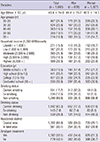2. Clarkson TW. The three modern faces of mercury. Environ Health Perspect. 2002; 110:11–23.
3. Ikingura JR, Akagi H. Methylmercury production and distribution in aquatic systems. Sci Total Environ. 1999; 234:109–118.
4. Ward DM, Nislow KH, Folt CL. Bioaccumulation syndrome: identifying factors that make some stream food webs prone to elevated mercury bioaccumulation. Ann N Y Acad Sci. 2010; 1195:62–83.
5. Auger N, Kofman O, Kosatsky T, Armstrong B. Low-level methylmercury exposure as a risk factor for neurologic abnormalities in adults. Neurotoxicology. 2005; 26:149–157.
6. Clarkson TW, Vyas JB, Ballatori N. Mechanisms of mercury disposition in the body. Am J Ind Med. 2007; 50:757–764.
7. Kwon YM, Lee HS, Yoo DC, Kim CH, Kim GS, Kim JA, Lee YN, Kim YS, Kang KM, No KM, et al. Dietary exposure and risk assessment of mercury from the Korean total diet study. J Toxicol Environ Health A. 2009; 72:1484–1492.
8. National Institute of Food and Drug Safety Evaluation. Dietary intake and risk assessment of contaminants in Korean food. National Institute of Food and Drug Safety Evaluation;2009. p. 133–154.
9. Choi H, Park SK, Kim MH. Risk assessment of mercury through food intake for Korean population. Korean J Food Sci Technol. 2012; 44:106–113.
10. Moon HB, Kim SJ, Park H, Jung YS, Lee S, Kim YH, Choi M. Exposure assessment for methyl and total mercury from seafood consumption in Korea, 2005 to 2008. J Environ Monit. 2011; 13:2400–2405.
11. Endo T, Yong-Un M, Baker CS, Funahashi N, Lavery S, Dalebout ML, Lukoschek V, Haraguchi K. Contamination level of mercury in red meat products from cetaceans available from South Korea markets. Mar Pollut Bull. 2007; 54:669–677.
12. Kim NS, Lee BK. Blood total mercury and fish consumption in the Korean general population in KNHANES III, 2005. Sci Total Environ. 2010; 408:4841–4847.
13. Lee JW, Lee CK, Moon CS, Choi IJ, Lee KJ, Yi SM, Jang BK, Yoon BJ, Kim DS, Peak D, et al. Korea National Survey for Environmental Pollutants in the Human Body 2008: heavy metals in the blood or urine of the Korean population. Int J Hyg Environ Health. 2012; 215:449–457.
14. Son JY, Lee J, Paek D, Lee JT. Blood levels of lead, cadmium, and mercury in the Korean population: results from the Second Korean National Human Exposure and Bio-monitoring Examination. Environ Res. 2009; 109:738–744.
15. National Institute of Food and Drug Safety Evaluation. Human risk assessment of heavy metals in food for safety management systems. National Institute of Food and Drug Safety Evaluation;2010. 10162RA994-401.
16. Kim HY, Kim JC, Kim SY, Lee JH, Jang YM, Lee MS, Park JS, Lee KH. Montitoring of heavy metals in fishes in Korea. Korean J Food Sci Technol. 2007; 39:353–359.
17. Yaginuma-Sakurai K, Shimada M, Ohba T, Nakai K, Suzuki K, Kurokawa N, Kameo S, Satoh H. Assessment of exposure to methylmercury in pregnant Japanese women by FFQ. Public Health Nutr. 2009; 12:2352–2358.
18. Lee HS, Cho YH, Park SO, Kye SH, Kim BH, Hahm TS, Kim M, Lee JO, Kim CI. Dietary exposure of the Korean population to arsenic, cadmium, lead and mercury. J Food Compost Anal. 2006; 19:S31–S37.
19. Li P, Feng X, Qiu G. Methylmercury exposure and health effects from rice and fish consumption: a review. Int J Environ Res Public Health. 2010; 7:2666–2691.
20. National Research Council. Toxicological effects of methylmercury. Washington, D.C.: National Academy Press;2000.
21. Zukowska J, Biziuk M. Methodological evaluation of method for dietary heavy metal intake. J Food Sci. 2008; 73:R21–R29.
22. Kipnis V, Midthune D, Freedman L, Bingham S, Day NE, Riboli E, Ferrari P, Carroll RJ. Bias in dietary-report instruments and its implications for nutritional epidemiology. Public Health Nutr. 2002; 5:915–923.
23. Stern AH, Gochfeld M, Weisel C, Burger J. Mercury and methylmercury exposure in the New Jersey pregnant population. Arch Environ Health. 2001; 56:4–10.
24. Sirot V, Guérin T, Mauras Y, Garraud H, Volatier JL, Leblanc JC. Methylmercury exposure assessment using dietary and biomarker data among frequent seafood consumers in France CALIPSO study. Environ Res. 2008; 107:30–38.
25. Xue J, Zartarian VG, Liu SV, Geller AM. Methyl mercury exposure from fish consumption in vulnerable racial/ethnic populations: probabilistic SHEDS-dietary model analyses using 1999-2006 NHANES and 1990-2002 TDS data. Sci Total Environ. 2012; 414:373–379.
26. Carrington CD, Bolger MP. An exposure assessment for methylmercury from seafood for consumers in the United States. Risk Anal. 2002; 22:689–699.
27. Tran NL, Barraj L, Smith K, Javier A, Burke TA. Combining food frequency and survey data to quantify long-term dietary exposure: a methyl mercury case study. Risk Anal. 2004; 24:19–30.






 PDF
PDF ePub
ePub Citation
Citation Print
Print







 XML Download
XML Download